
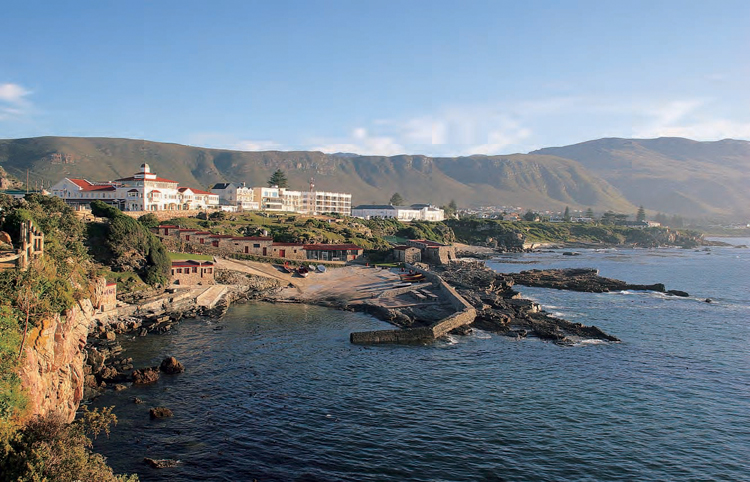
Hermanus’s Old Harbour – a good spot to look for whales between June and December.
Whales have totem status in Hermanus.
It is one of life’s finer pleasures to sit on the rocks in Walker Bay, with the tourist buzz of Hermanus to one’s back, and quietly observe the great pods of southern right whales coming in to show off new babies and generally rest up from their hectic Antarctic krill-feasts.
Every time Jules and I go to watch the whales in the late afternoon light, a feeling of quiet, exultant joy spreads over us like magical fairy dust. I’m a hoary old hack who’s seen it all, but there’s some kind of rapture about seeing a southern right lolling only metres away from the clifftop viewpoints.
This species of whale is enjoying an amazing comeback from the brink of extinction. There are now more southern right whales off the South African Cape coast than at any time in the past one hundred and fifty years. By 2006, well over 2 000 were visiting South Africa’s shores each year, and their numbers were doubling every decade.
The whales – called right whales because they were the “right” whales to hunt – were down to a tiny group of 40 adult females off the South African coastline by 1940, when it was finally decided that they were to be protected. There used to be nearly 300 000 in the southern hemisphere before intensive whaling kicked in around the eighteenth century – and they are now up to a total of about 12 000, thinly spread across the southern oceans.
The whale-watching industry in South Africa is growing by 40 per cent a year. Worldwide it’s a $1-billion business. No small potatoes, even for the lobbyists in the “If It Pays, It Stays” camp of conservation.
Land-based whale-watching is becoming so popular in South Africa that it brings more tourists to these shores than the celebrated Kruger National Park, which offers the Big Five of the animal kingdom. And where the whales go, the merchandising is not far behind. Hermanus is awash with whale symbolism, whale “stuff” and very good art inspired by whales. There’s a whale festival, a nearby estate offers a superb southern right brand of wines, and a string of guest houses and restaurants fly the whale logo – the sleepy little town of Hermanus has become Whale Central to the world.

Hermanus’ high clifftops and deep seas offer excellent shore-based whale-watching.
Out on the rocks overlooking the sea, flocks of visitors and locals gaze out for hours in a reverent whale-trance, hoping for the sight of a fluke or a waterspout. The whale-watching here from June to December is world class – the clifftops edging onto deep sea gullies mean the whales come right in, sometimes only metres away from their audience.
One morning early, we leave our digs at Inkwazi B&B in Hermanus and drive off to Gans Bay to join Dyer Island Cruises for a boat-based encounter with whales.
I am looking to shoot the perfect “sailing” photograph of any whale we encounter. “Sailing” is what happens when the whale stands perpendicular to the sea and all that one views is a lovely tail. I feverishly want that tail. I’ve been out to sea for whale tail more than a dozen unsuccessful times, and it has become somewhat of a mission.
Attired in bright orange macs and life jackets, we walk in a saffron cloud of eager tourists down the main road of Kleinbaai to the little harbour and onto Wilfred Chivell’s boat, Whale Whisperer. Once out at sea, we pass the good boat Shark Fever, which has just hit the jackpot. A great white is showing off its “Air Jaws” manoeuvres to the stunned group of adventurers on board. But for me, today is Whale Day – the shark thing will wait for another time.
We come across a gathering of brindled southern right whales engaged in recreational sex. (Brindles are born pure white, but by the time they are adult they acquire a few darker patches.) Pale Male, as we call him, is schmoozing a far larger female, turning and exposing his snowy belly to her. They begin embracing one another with their flippers. Everyone on board laughs quietly, totally seduced by the scene. The whales peer at us briefly before rolling back onto one another with an air of measured exuberance. But not one of them shows the faintest urge to “sail” for my sweaty cameras.
A southern right surfaces to breathe and perhaps peer at watching humans, exposing the characteristic “bonnet” of its callosities. Despite their 60-ton bulk and the fact that humans hunted them for centuries, these whales are completely harmless.
There’s some kind of rapture about seeing a southern right lolling only metres away.
The classic “sailing” pose.
Walker Bay is now a declared whale sanctuary.
Then the girl whale rests her head on Pale Male, forming an affectionate T-shape, and I forget my particular mission for the moment. We are transfixed by these great animals.
It seems only appropriate to celebrate at Bientang’s Cave back in Hermanus, a restaurant named after the last-known Strandloper in the area.
Bientang, according to legend, lived in a nearby cave in the late 1700s and, by all accounts, made a very comfortable nest for herself. She drank water from a constant mountain stream, gathered seafood and cultivated a little veggie garden.
Bientang was said to communicate with all manner of animals, including the southern right whales. And the legend goes that year after year the whales would return to this spot in Walker Bay to speak with her. Perhaps to give her an update on matters down south where the emperor penguins hung out.
That job is done these days by one Godleck Baleni, the only official Whale Crier in the world. Godleck, who recently took over from Wilson Salakusana, walks along the cliffs being photographed by tourists and when he spots whales he lifts his kelp horn and calls the faithful. Who seem to respond, in their thousands, from all over the world. – Chris
Blue cranes, South Africa’s national birds, stalk the Overberg wheatfields in summer.

Gans Bay is one of the easiest places in the world to see great white sharks because of the abundance of Cape fur seals. Worldwide, sharks are threatened by illegal trade in shark fins.
“A day without sharks is a day without sunshine.”
Those are the words of shark-diving legend Brian McFarlane, who runs a boat called Predator out at Kleinbaai, a small boat harbour within the greater Gans Bay, in the southern Cape. We’re out at sea with his crew and a young adventure-nut called Roger Underdown, a night-shift maintenance fitter from Kent, England.
The cheerful traveller is going to meet a great white today from the confines of a lowered cage near Dyer Island, which is where the sharks normally gather for their McSeals Supersized.
Four hours later, as he emerges from the cage, you can see Roger has clearly had an epiphany. His hands shake, his eyes shine and the words come tumbling from his mouth.
From the viewing deck on Predator, I am equally awed. A four-metre great white shark has come boiling out of the water in pursuit of Brian’s foul-smelling chum and for a while it’s all about many white teeth and grey speed and those eyes, those implacable ebony eyes I remember from childhood nightmares – and, of course, the movie Jaws. But the feeling has nothing to do with terror – it’s more like deep respect.
This living cruise missile has been here, in this perfect form, master and commander of the southern seas, for many millions of years.
Brian McFarlane spent his childhood days diving for perlemoen.
“I was paid sixpence a perly,” he said. “I probably earned more than my schoolteachers. At 16, I had a Jeep and a boat. I could not see the benefits of going to school any longer, so I left for a life at sea.”
After many years of diving for diamonds and sunken treasure, Brian McFarlane decided to come home to Hermanus and settle down. He bought the old clubhouse on the local golf course and set up a guest house. But he kept breaking plates and missing the sea, so he left the running of the guest house to his wife, Sandy.
Brian bought a small boat for fishing and tourist excursions. That “little business” has morphed into Predator II, a large boat that can take 20 passengers.
The sharks are attracted by chum in the water, and then lured in with hunks of fish.
“I was bitten by Jaws,” says Stu. “It’s been a lifelong dream to see a great white shark up close.”
The effect of the shark cage-diving business on the little town of Gans Bay is astounding. It is now an established industry worth more than R30 million annually.
And because the shark cage-diving excursions have become such an entrenched, important sector of the local economy, the raging controversy about the effects of cage-diving on shark behaviour – especially attacks on humans in the water – is carefully watched from the sidelines.
We ask Brian McFarlane why cage-diving with sharks has become so popular. It is by far the most sought-after adventure activity among foreign tourists visiting the province.
“I put it down to Jaws,” he says. “The book and the movie scared people out of the water – and into a boat. Jaws made sharks into monsters, but it also gave them a mystique. People want that thrill of being safe in the presence of the monster.”
When we’re out at sea, it immediately becomes obvious that each shark has its own character and preferences. Some seem playful and curious. Some are shy, contenting themselves with circling the boat. Others are aggressive and surge after the tuna bait like starved prisoners. There’s one well-documented shark that liked to be tickled just in front of its gills. In fact, it kept returning to the boat concerned, just to be tickled there again and again.
Don’t make the mistake of thinking the sharks loiter about tourist boats, habituated to a daily snort of chum. Most are only passing through, many on epic trans-oceanic voyages, like one great white female, satellite tagged and nicknamed Nicole. In ninety-nine days she migrated briskly from Gans Bay to Australia and back again, the fastest trip by a marine animal ever recorded.
We return for more with the Predator Gang on a bright October day in 2005. Skipper for the day is Rozier (Rozy) Steensma, a spitting image of the rock musician Huey Lewis.
We have a full complement of tourists, including Anna and Stu Durand from Brighton, England. The English seem to like admiring sharks.
“I was bitten by Jaws,” says Stu. “It’s been a lifelong dream to see a great white shark up close.”
The sharks are slow to arrive at first. Then, as they scent the chum in the water, they begin cruising around the boat. People fall over themselves to get the perfect picture.
Stu and Anna throw on wet suits and join three others in the large cage attached to the side of the boat. The shark follows a lump of tuna right up to the caged tourists, and when it is whipped away, begins attacking one of the inflatable pillows holding the cage buoyant.
Anna eventually comes out, in a very excited state. She grabs her cellphone and contacts her six-year-old son back in England.
“He’s huge, darling, I can see him now. He’s at least four metres long. He’s coming up to the boat now, right as I’m speaking to you.”
Stu, in the meantime, is staying below and drinking in every bit of adrenaline on offer.
The shark cage-diving business brings people closer to the great white populations than ever before. They go out for the thrill of fear, they return with deep respect for the fish in question. People like Brian McFarlane don’t have to break dishes in guest houses, tourists visiting these shores have another all-day adventure option and the sharks get to strut their fearsome stuff in the water. – Chris
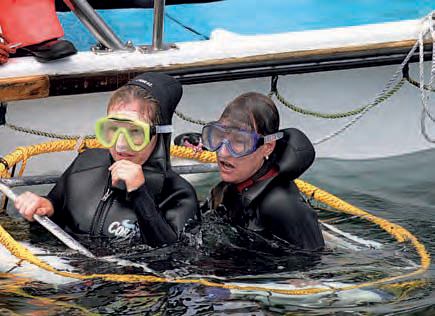
The shark-viewing business is now worth R30 million a year, fascinating tourists from all over the world. Part of the thrill is being able to safely see the sharks in their element.
Most sharks seen by tourists at Gans Bay are only passing through, on epic trans-oceanic voyages.
Unwary seals become shark food in “Shark Alley”, near Dyer Island.
Danger Point lighthouse is close to where the Birkenhead sank, south of Gans Bay.
In the old days an advert for a lighthouse keeper might have read: “Wanted: person of sober habits with a liking for solitude, an aptitude for saving ships in distress and a tolerance for repeated foghorn blasts. Must be fluent in Morse code and semaphore and handy with cranks and gas burners, and must relish dressing in white. Vertigo-sufferers and the colour-blind need not apply. Insomniacs welcome. Pets optional.”
These days, a lighthouse keeper is a jack-of-all-trades, everything from a janitor to a meteorologist to a tour guide, and, in some places, a gracious host.
Decades ago, before electrification, each of South Africa’s lighthouses needed three staff members: the lighthouse keeper and two assistants. To the latter fell the miserable daily task of keeping spanking white uniforms clean while removing all soot that blackened the enormous glass lens in the days of wick and paraffin vapour burners.
Then, when the first lighthouses were automated from the 1960s onwards, staff needs sank to two, and then to one, and eventually, in most cases, to none. Only 15 of South Africa’s 45 lighthouses are staffed today. In fact, lighthouse keepers are becoming an endangered species. South Africa is among very few countries in the world where some lighthouses are still staffed.
With the drop in staff numbers, cottages fell into disuse and became an irksome maintenance cost to the Lighthouse Services of the National Ports Authority (NPA). But just after the turn of the millennium, the NPA saw the light and an opportunity to turn a liability into an asset.
As a more or less direct result, South African Lighthouse Adventure Tour Operations (SALATO) was formed in 2002, and the cottages upgraded. SALATO offers self-catering accommodation in some of the country’s most spectacular coastal areas, usually within a nature reserve, surrounded by a fascinating history of shipwrecks and derring-do.
Practically every lighthouse is a response to a spectacular shipwreck, or a series of them. The reason for Slangkop lighthouse at Kommetjie on the Cape Peninsula is a fair example. In May 1900, the Kakapo, a brand new 1 000-ton steamer, headed out from Swansea, Wales, on its delivery voyage to Sydney, Australia, Captain P Nicolayson at the helm.

Nico Saal became a lighthouse officer because his father died at sea when he was a small child, and he wanted to save others from the same fate.
Slangkop near Kommetjie is the tallest tower on the South African coast.
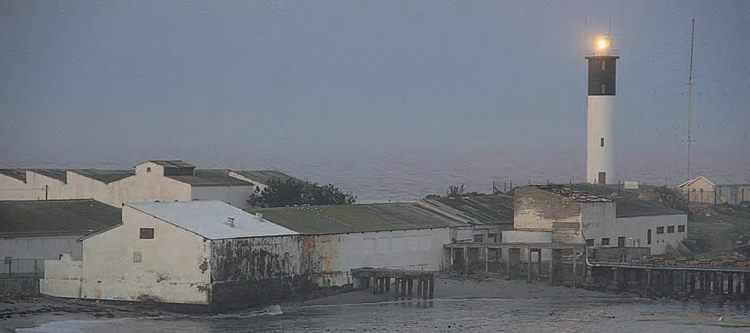
The original lighthouse at Doring Bay was destroyed in a gale in 1991.
There was a lively north-wester blowing, and it was raining hard when the ship left Table Bay in the late afternoon, fully laden with fuel coal. In the failing light, the captain mistook Chapman’s Peak for Cape Point. He turned briskly to port, apparently called for full steam ahead, and for a few minutes was making good progress in what he thought was the direction of Port Elizabeth.
He was rudely disabused of this notion when the Kakapo ploughed straight into the beach at Noordhoek, threw up a considerable bow wave of sand, and came to a swift and undignified halt.
If you visit Slangkop lighthouse today, the Lighthouse Officer (the title of lighthouse keeper having, alas, fallen away), Peter Dennett, will tell you the mortified captain refused to come out of his cabin for weeks. Eventually he had to be gently escorted to an asylum for the insane.
Cape Agulhas lighthouse was built when a farmer, whose land stretched to the southern tip of Africa, begged for official intervention. Mr Van Breda, whose farm was even named after a shipwreck, was quoted as follows: “I have been painfully called on to witness, with my own eyes, ship after ship cast away, valuable cargoes strewn along the beach and hundreds of human beings at a time washed up dead upon the shore. There was the Arniston on 13 July 1819, a total wreck; when out of 365 people on board, only five escaped. No less than 360 dead bodies of men and women and children were washed ashore, and what is more, they lay there for a week before any man knew their fate. I saw them with my own eyes, torn and partly devoured by preying vultures ...”
Danger Point lighthouse at Gans Bay was erected 43 years after the British troopship HMS Birkenhead foundered on an uncharted reef, only 1 500 metres offshore. More than 400 soldiers stood obediently to attention on the sinking deck as they watched three lifeboats take women and children to shore – the first time, they say, the phrase “women and children first” was ever used. Many of the men tried to swim to safety but most were drowned or attacked by sharks.
One of the reasons 15 of South Africa’s lighthouses remain staffed is because South Africa has one of the world’s most treacherous coastlines, with plenty of hidden reefs and rocks for ships to founder on. And the Cape of Storms often lives up to its name.
Slangkop lighthouse officer Peter Dennett vividly remembers the evil gale-force wind of 5 September 2001. He calls it “a real northwest buster, a monster of a storm”. It whipped up the swells to a towering 17 metres and hoisted the freighter Ikan Tanda, her malfunctioning engines and her dragging anchor onto the rocks at Scarborough.

Cape Agulhas lighthouse marks the southernmost point of Africa.
Left Cape Columbine lighthouse, completed in 1936 on the West Coast, was the last staffed lighthouse to be built in South Africa.
Right Cape Hangklip at False Bay was the first fully automated lighthouse on the South African coast.
Peter was watching the riveting scene from the best viewing (and best-lit) platform possible – the top of the cast-iron lighthouse, 33 metres above the sea. He kept in constant touch with the captain of the ship, who was desperately trying to revive his ailing main engine, and the Port Captain, who dispatched a tug and a rescue helicopter. No one was drowned that day.
The island lighthouses were considered the most challenging. In the days before helicopters, tugs struggled to bring supplies, and until the days of radio transmitters, communication between remote Bird and Dassen islands and the mainland had to be delegated to homing pigeons.
Port Shepstone-based Henry Clapton has worked at most of South Africa’s lighthouses, including that on Robben Island, and now offers tours to them. He remembers his stint at Cape St Lucia lighthouse most vividly for all its rescues: “It’s a really treacherous stretch of the coastline because of winds and currents. On a stormy night, I’d sometimes get a mayday call – a yacht that had turned turtle, maybe, its rigging broken. We were the only ones that could pick up their frequency. I would call through the co-ordinates to the National Sea Rescue Institute, and they’d kick into operation, sending a boat blind towards the GPS position I’d given them, in eight- or ten-metre swells, wind changing direction all the time, to find the boat and tow it back in. Amazing stuff.”
Lighthouse officers are crucial for rescues, meteorological reports, security and maintenance. But it is tourism, in Dennett’s opinion, that has revived and ensured the continuation of the lighthouse-keeping profession.
Shellfish abound on the rocky shores so treacherous to ships.
“We’re trained as tour guides as well, but we come from a proud tradition, a heritage. We’re the real deal. We speak from experience.”
His day starts at 7 a.m., with reports to the South African Weather Service on swells, wind speed and direction, barometric pressure and coded cloud types (the beautiful fluffy cumulonimbus clouds are Cloud 9), and a chat to fishing-boat skippers on where they’re headed.
By 10 a.m. he has vacuumed the place, polished the brass, and cleaned the enormous glass lens 145 steps above the ground, and is ready to receive the first tourists of the day. – Julie
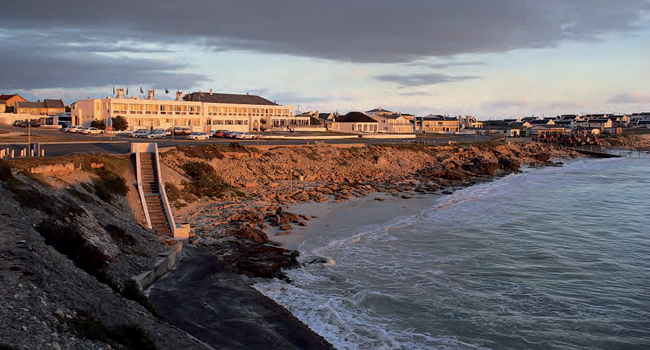
The classic Arniston Hotel sitting snug next to the fishing village of Kassiesbaai.
A sign at the little Anglican Church at Kassiesbaai, a tiny fishing village within the greater village of Arniston, announces the 10 a.m. Holy Eucharist. We rush back down the hill to our room at the Arniston Hotel to get properly dressed for church.
We sit at the back of the simple building, which is soon quite full. A few women come in with their heads covered, and genuflect and cross themselves.
Outside, five girls in red-and-white smocks wait for the service to begin. One of them briefly twirls an incense burner over her head, as if it were a fire stick you see at trance dances.
At 10 a.m. exactly, with an air of great ceremony, three priests walk in, led by the altar girls bearing crosses, candles, Holy Communion wafers and a small bell.
Father Eli Murtz leads the service. His message revolves around a reading about the Good Samaritan.
“Take a good look around,” he says. “See who your real neighbour is.”
Perhaps he has noticed the two strangers at the back of the church, because he continues, “We have to help people of all races and backgrounds, and see everyone as our neighbour.”
We pray for the community, and the priests ask the parishioners to remember Americans suffering in hurricanes (Katrina having recently had her way with New Orleans) in their prayers.
They also offer a special prayer for anyone who wants to come forward for a particular reason. A man asks to have his young son blessed because it is his birthday. The priest prays, placing his hands on their heads.
There is a slow build-up to the drama of the Holy Communion. Readings are made. The priest is surrounded by altar girls who hold up the Bible, illuminating it with candles.
The rocky shores off Arniston – disaster for old-time trading vessels.
The incense is lit, and swung back and forth. The priests gather round the small altar. A woman holding up a Bible rests her hand over her heart.
The spiritual tension grows. The community has now completely forgotten about us, and is entirely focused on the scene before it, the tableau. There is a hushed reverence. The church is lit with candles and becomes wreathed in incense and fervent, tangible prayer. The people give the moment their full attention, and breathe holiness into it. Everyone is uplifted by the time Father Eli holds up the Host, and one of the altar girls rings a bell.
The singing after that is joyous. Not just another “Kumbaya moment”. In religious layperson’s terms, it rocks.
At the moment of peace, everyone around us reaches out to shake our hands, and we smile shyly at one another. Peace. Peace. Peace. – Julie
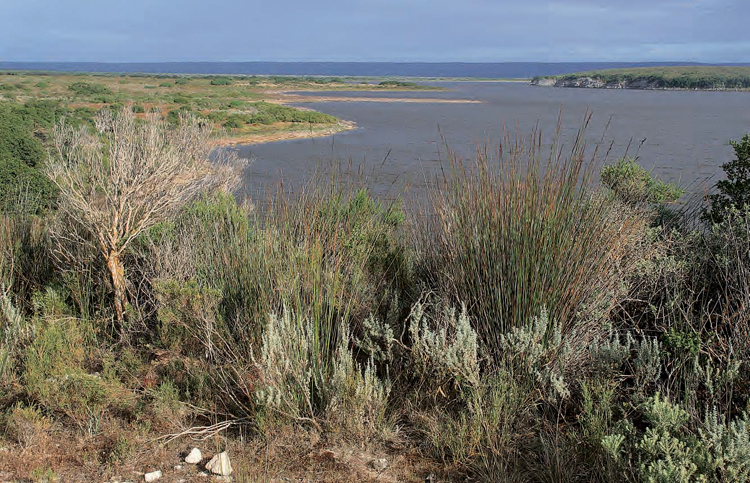
De Hoop Nature Reserve has a fascinating history and its dunes offer some of the best vantage points for seeing whales. Southern right mothers often come to calve there.
De Hoop Nature Reserve, the famous whale sanctuary, is best viewed in the cheery light of a sunny day. We arrive in a blizzard of leaves and dust, with a gunmetal sky looming down over the horizon. There are strong rumours of a Cape storm arriving soon. Within the hour, the rain is pelting down and we find ourselves temporarily marooned in the little De Hoop Museum near our chalet. Instead of whales, we find something just as valuable: The People of De Hoop Nature Reserve: A Cultural–Historical Heritage, compiled by Ann and Mike Scott of the Overberg Conservation Services. We ignore the storm bellowing outside and read.
During the floods of 1906, the 36 000 sprawling hectares where De Hoop stands today were completely submerged. On Sundays, the extremely sociable farmers of the area visited each other by lifeboat, skiff or, in some cases, crudely built rafts.
This is where the farm Melkkamer once flourished, under the talented and eccentric hand of one John Henry (Biddy) Anderson.
After seven days of constant rain, with water levels ever-rising, the Wilsons of nearby Skipskop Farm decided to visit Biddy Anderson to see if he wanted a bite and some help bringing his livestock to high ground of sorts. Their arrival had to be unannounced, because all “comms” were down. So the Wilsons packed a picnic lunch, jumped in their lifeboat and rowed on over to Melkkamer.
Biddy and his building partner, a man called Dickson, had been hard at work, putting up a loft in the stables. But the rain had temporarily halted all construction, and the flood level was cause for concern. Biddy, for some reason, had a piano downstairs in the stable. He and Dickson manoeuvred it upstairs to the newly built loft. Biddy looked out of the window at the world of water and decided “What the heck?”. So they stalked back downstairs and brought up a case of whisky.
And this is how the Wilsons found Biddy Anderson and the man called Dickson: in fine musical whisky spirits up in the loft, tinkling the ivories without a care in the world.
Before Biddy Anderson’s day, there was a slave called Februarie, originally from Hangklip near Pringle Bay. Februarie had been a droster (runaway slave) who chose to live as an outlaw instead of at the foot of a colonial master. He wandered up the coast some time in 1850 and set himself up in a cave on the north-west corner of what later became the Melkkamer property.
De Hoop is one of the few places where lowland fynbos has been preserved. Elsewhere, agricultural activities have fragmented the ecosystem.
Initially, Februarie was well liked. He lived by hunting and collecting honey where he could find it, exchanging the sweet dripping combs for food with workers on surrounding farms. Then he got sly, and that’s when the trouble began.
Februarie started taking the workers’ wives hostage, extorting clothes, tobacco, candles and other supplies from them. Every now and again he would steal a sheep from one of the surrounding farms. His cave had a narrow entrance, which he could easily defend. Besides, when life became too harrowing for him here, Februarie would decamp to another cave at Kathoek in a kloof to the southeast. The farmers were upset about their stolen sheep and decided to do something about it. Februarie was captured and executed.
Then came the tale of the “hapless Mrs Cloete”, who was given a huge oyster by her husband at their wedding feast. She choked to death on the oyster, in front of all the guests and her horrified husband, who blew his brains out with a shotgun blast shortly thereafter. The oyster shell was mounted above the front door of the old house on the homestead.
The records suggest that the ghost of the “hapless Mrs Cloete” danced in the attic, while the ladies of the Anderson family frolicked below in their bare feet to the stirring concertina tunes played by one Oom Frikkie. These festivities were, apparently, made even more memorable by the cask of sweet wine that a certain Oom Serfaas would bring over from Wellington from time to time.
I found another Boy’s Own story.
“Listen to this one. It’s about all the German U-boats that used to sail around Cape Infanta during World War II. Disguised as fishermen, the crews would come up the Breede River in rubber dinghies, go ashore and shop at Port Beaufort.”
The German seamen would stock up on food and diesel for their U-boats, which were decimating Allied shipping around the Cape at the time. They lay out in the waters of both the Indian and Atlantic like waiting wolves, with rich pickings on offer. But after a while the fuel gauge would drop, the breakfast milk would sour and the Chief Engineer would have scoffed all the sausage in the galley. When the going got tough on the U-boat, the U-boat guys went shopping.
When U-boat men came strolling up the main road dressed either as tourists or fishermen, the shopkeeper didn’t always report the sighting to the cops. In fact, when the shopkeepers saw just how much the German seamen were willing to pay for goods, they shut the hell up and took the money.
But the police and, subsequently, Jannie Smuts’s government, came to hear of these unscheduled tours of the Agulhas Plain. So they sent in government agents “also dressed as holiday makers” to snoop around. Can you imagine the sight of all these lumpy-eared types trying to be so nonchalant around tiny Port Beaufort?
I read: “Pypie, a local shepherd, witnessed a German U-boat sending men ashore and was sworn to silence. Terrified that his family would be killed, he kept the secret for at least thirty years.”
Then there was the story about the German officer, whose body was found washed up along the coast. In the inner pocket of his uniform were two used tickets for a performance at Cape Town’s Alhambra Theatre. – Chris

Wheat ripening in the Overberg.